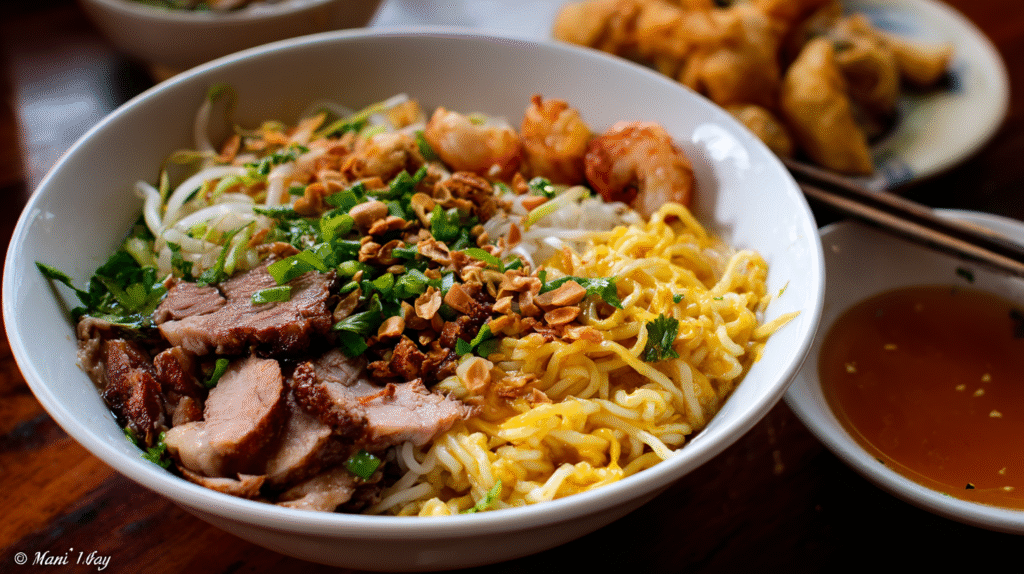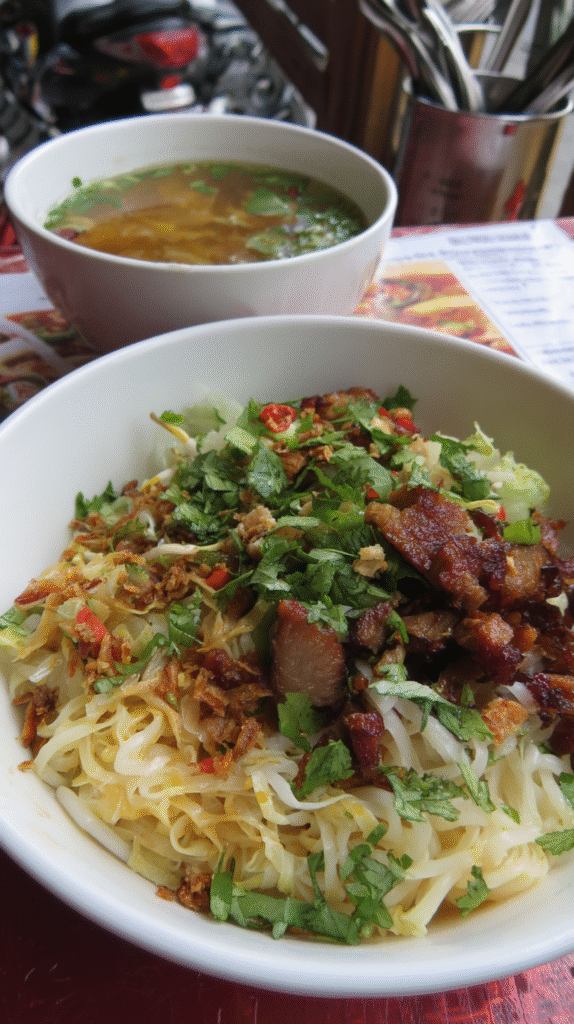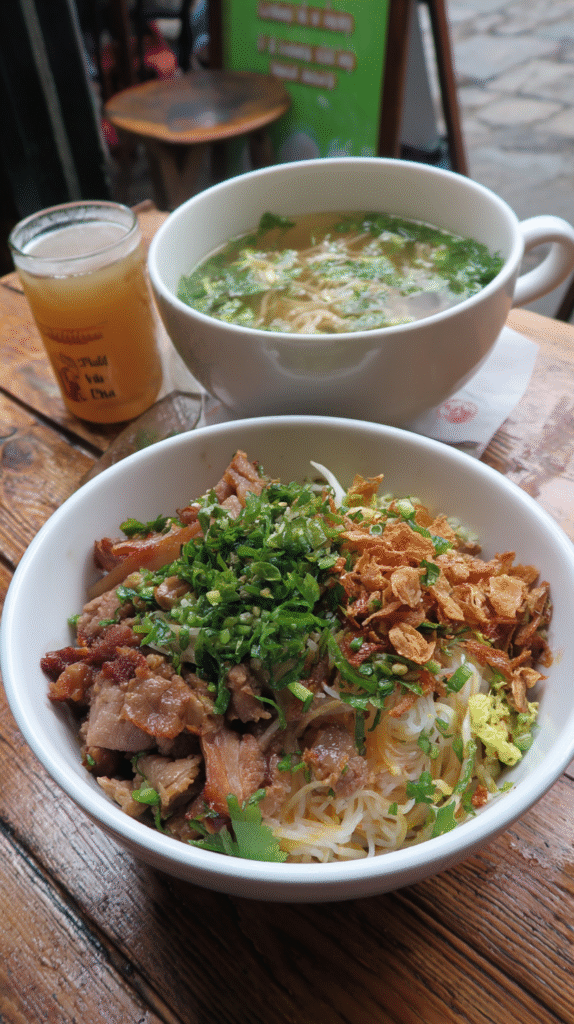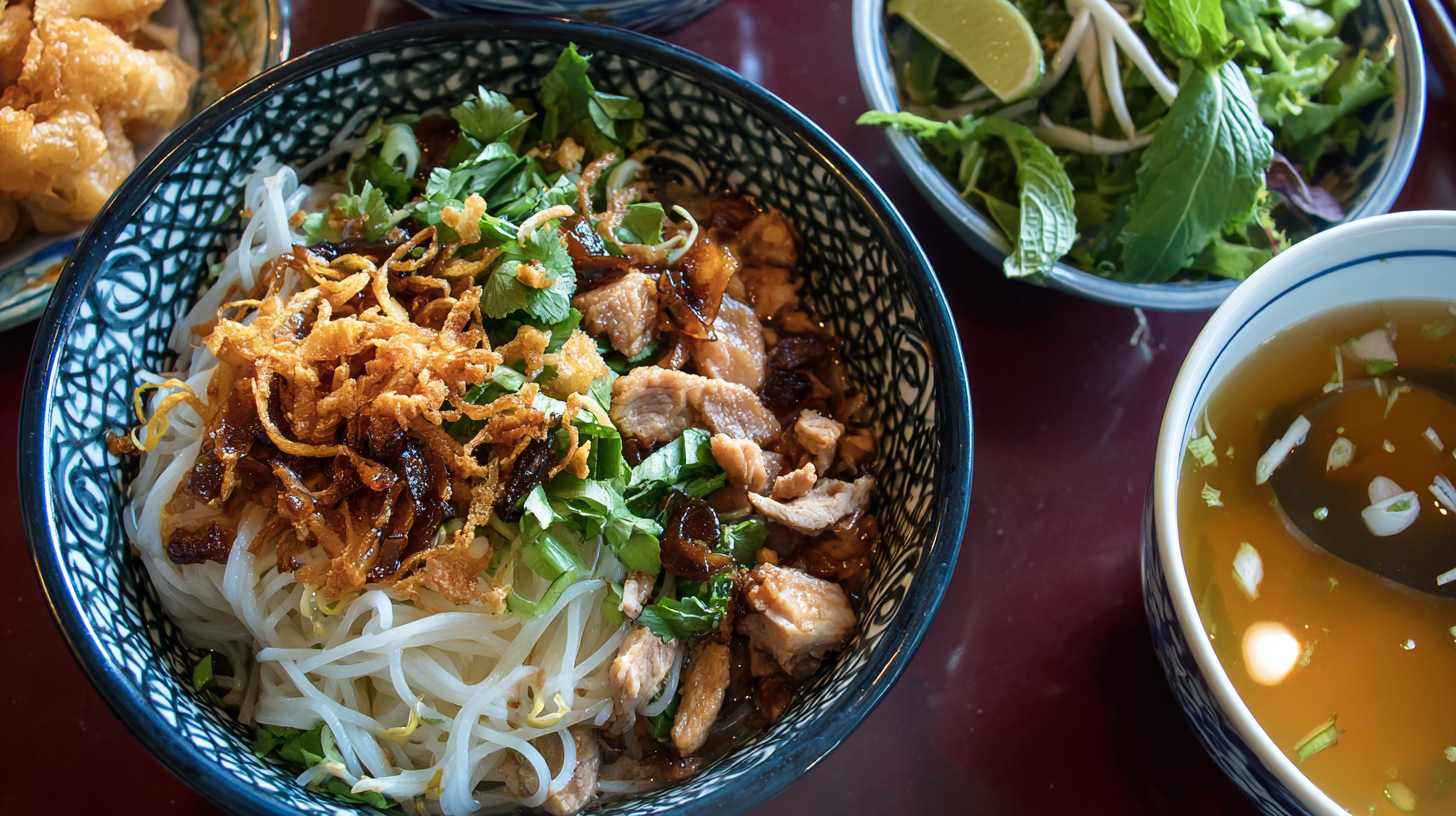If you’re craving bold flavors and a satisfying noodle dish, hủ tiếu khô is a must-try. This Vietnamese specialty, often called “dry noodle soup,” is a delightful mix of chewy rice noodles, savory toppings, and a side of rich broth. It’s like getting the best of both worlds—tossed noodles with a flavorful sauce and a comforting soup to sip on.
Hailing from the southern region of Vietnam, hủ tiếu khô showcases the vibrant street food culture the country is known for. Each bite is a perfect balance of textures and tastes, from tender slices of meat to the crunch of fresh herbs and fried garlic. It’s a dish that feels both hearty and refreshing, making it perfect for any time of year.
What Is Hủ Tiếu Khô?

Hủ tiếu khô, or “dry noodle soup,” is a beloved Vietnamese dish that offers a unique twist on the classic noodle experience. Unlike traditional soup noodles, this dish separates its components—tender rice noodles are served dry with a flavorful sauce, while a bowl of piping-hot broth accompanies it on the side. The contrasting textures and flavors come together to create a harmonious and satisfying meal.
At its core, hủ tiếu khô highlights balance. The chewy noodles soak up the rich, savory sauce, while a variety of protein toppings like seasoned pork, shrimp, or quail eggs add depth and heartiness. Fresh herbs, crispy fried shallots, and pickled vegetables enhance the dish further, bringing bursts of freshness and crunch. Meanwhile, the broth, often simmered with bones and aromatic spices, is served alongside to sip or pour over the noodles according to personal preference. Every element is carefully crafted to offer a little bit of everything—bold, fresh, and comforting flavors with a customizable experience.
Ingredients

Preparing hủ tiếu khô requires a careful balance of authentic ingredients to bring out its signature flavors and textures. Let’s break it down into key components.
For The Noodles
- 8 ounces hủ tiếu noodles (preferably, tapioca-based for their chewy texture)
- Optional: Phở noodles (rice noodles) or Mì noodles (egg noodles) as substitutes
For The Sauce
- 1 teaspoon tapioca starch
- 2 teaspoons water
- 2 tablespoons oil (lard or tallow for a rich flavor)
- 1 large shallot, minced
- 4 cloves garlic, minced
- 3 tablespoons oyster sauce
- 2 tablespoons light soy sauce
- 5 tablespoons tomato sauce
- 3 tablespoons granulated sugar
- 1/4 teaspoon MSG (optional, for added umami)
- 1 cup chicken stock
- Vietnamese chili sauce and pickled jalapeños (optional, for heat and tanginess)
For The Toppings
- 6 ounces seasoned pork, cooked and sliced thinly
- 4 medium shrimp, deveined and cooked
- 2 quail eggs, boiled and peeled
- 4 ounces fried tofu cubes (optional)
For The Garnishes
- 2 tablespoons crispy fried shallots
- 2 tablespoons fresh cilantro leaves, chopped
- 2 green onions, finely chopped
- Fresh bean sprouts, rinsed and drained
- Lime wedges (to taste)
- Vietnamese pickled vegetables (optional, for crunch and tang)
Tools And Equipment

When preparing hủ tiếu khô, having the right tools and equipment is essential for streamlining the cooking process and achieving authentic flavors. Below, we outline the must-have items and their specific roles in crafting this delicious dish.
- Large stock pot: We use this to blanch pork bones and prepare the rich, aromatic broth that accompanies hủ tiếu khô. Its size allows us to simmer the bones and other ingredients for an extended time, extracting the fullest flavors possible.
- Colander: After blanching the pork bones, this is perfect for rinsing the bones thoroughly to remove any impurities.
- Baking tray or toaster oven: Essential for roasting aromatics like garlic and dried seafood. This step adds a deep, smoky flavor to the broth and overall dish.
- Small pot or pan: We need this to make the sauce that coats the noodles. A small, non-stick pan works well for gently simmering ingredients like oyster sauce, soy sauce, and chicken stock.
- Cutting board and knife: These are vital for prepping ingredients like pork, shrimp, and fresh vegetables. A sharp knife ensures precision in slicing and mincing, while the cutting board provides a sturdy workspace.
- Measuring cups and spoons: Accuracy is key to perfecting the sauce and broth. We rely on these tools to measure ingredients like fish sauce and sugar, ensuring a consistent flavor profile.
- Grater or ricer: If we add carrots or daikon radish to the broth, a grater or ricer helps us finely grind these vegetables, enhancing the broth’s sweetness and body.
- Strainer or rây: To achieve a clear and smooth broth, we strain it with a fine-mesh strainer to remove solids like bone fragments or aromatics.
By equipping ourselves with these tools, we can efficiently tackle each step of the recipe and ensure our hủ tiếu khô turns out perfectly every time.
Directions

Let’s dive into crafting our hủ tiếu khô step by step. Follow these instructions to create a flavorful and satisfying dish at home.
Prep The Ingredients
- Cook 8 ounces of hủ tiếu noodles according to the package instructions. Rinse with cold water to prevent sticking and keep in a colander.
- Wash and chop fresh greens like lettuce, Asian celery, and chrysanthemum. Set aside.
- Peel and devein 4 large shrimp. Slice 6 ounces of lean pork thinly, and chop 2 cloves of garlic finely.
Make The Sauce
- In a small pot, combine 2 tablespoons oyster sauce, 1 tablespoon soy sauce, 2 tablespoons chicken stock, 1 teaspoon sugar, and a dash of black pepper.
- Stir the mixture over low heat until the sugar dissolves and the sauce slightly thickens. Set aside to cool.
Cook The Noodles
- Bring a pot of water to a boil. Add the prepped hủ tiếu noodles and cook as directed on the package (typically 3–5 minutes).
- Drain the noodles and drizzle a little vegetable oil over them to avoid clumping.
Prepare The Toppings
- In a pan, heat 1 tablespoon of vegetable oil. Add the minced garlic and sauté until fragrant.
- Cook the sliced pork and shrimp in the same pan until fully cooked. Set aside.
- Hard-boil 2 quail eggs, peel them, and keep them ready for garnish.
Assemble The Dish
- Place a portion of cooked noodles into each serving bowl.
- Drizzle the prepared sauce over the noodles, tossing gently to coat.
- Top with cooked pork, shrimp, quail eggs, fresh greens, bean sprouts, and fried shallots.
- Serve with a piping-hot side of broth garnished with scallions, and enjoy!
Serving Tips

To fully enjoy hủ tiếu khô, proper serving and preparation on the table are essential. Here’s how we can make the most of this delightful dish:
- Begin by placing the thick, savory sauce at the bottom of each bowl. The sauce’s rich flavor is the foundation of hủ tiếu khô, so this step is crucial. On top of the sauce, layer the cooked noodles, ensuring they remain warm and chewy.
- Arrange the savory protein toppings like seasoned pork, shrimp, and quail eggs over the noodles. Sprinkle with a handful of crispy fried shallots, fresh herbs like cilantro or scallions, and a few lime wedges on the side for a pop of freshness.
- Serve a small bowl of piping-hot broth alongside the noodles. This broth isn’t just a side element; it’s a vital part of the dish’s experience. It can be sipped on its own or lightly drizzled over the noodles if desired, adding warmth and depth.
- Before eating, mix everything thoroughly. Stirring the noodles ensures that every strand absorbs the flavorful sauce, and no ingredient gets left out. The variety of textures and flavors blend beautifully once combined.
- For added customization, set condiments such as red vinegar, pickled chiles, or chili oil at the table. This allows us to tailor the flavor to our liking, making the hủ tiếu khô truly our own. A dash of chili oil or a splash of vinegar can elevate the dish’s complexity.
By serving hủ tiếu khô with attention to detail and options for personalization, we can create a meal that’s both interactive and incredibly satisfying.
Make-Ahead Instructions

Preparing hủ tiếu khô can be streamlined by making several components ahead of time. This way, we save time on the day of serving and ensure everything comes together seamlessly.
Noodles
We can cook the noodles ahead of time. Choose thin egg noodles or hủ tiếu dai (chewy rice noodles) for the best texture. Cook the noodles according to the package instructions, rinse them under cold water to stop the cooking process, and toss them with a small amount of vegetable oil to prevent sticking. Once prepared, store the noodles in an airtight container in the refrigerator for up to 24 hours.
Proteins
For the protein toppings, such as shrimp, squid, char siu (BBQ pork), fish balls, and quail eggs, cook them in advance to save time. For char siu, marinate and roast it up to 2 days ahead. Cook the shrimp and squid by blanching or stir-frying, and boil the quail eggs until hard. These proteins can be refrigerated in individual airtight containers for up to 2 days. If using fish balls, keep them in their original packaging and refrigerate until needed.
Sauce
The sauce is one of the most flavorful components and can easily be prepared ahead. Combine ingredients like shallots, minced garlic, fish sauce, soy sauce, oyster sauce, a touch of tomato paste, and chicken or vegetable broth. Heat until slightly thickened, then let the sauce cool completely. Store it in a sealed jar or container and refrigerate for up to 3 days or freeze it for up to 1 month. Reheat gently before serving.
Broth
A rich and aromatic broth is crucial for hủ tiếu khô. To make it ahead, simmer pork bones, chicken bones, dried shrimp, dried squid, and aromatics like onion and ginger for several hours. Strain the broth to remove solids, then let it cool completely. Store the broth in the refrigerator for up to 3 days or freeze it in portions for up to 1 month. On the day of serving, reheat the broth, skimming off any fat for a clean and flavorful side soup.
By preparing these elements in advance, we ensure that assembling hủ tiếu khô becomes a quick and enjoyable process, allowing us more time to savor the delicious flavors of this beloved Vietnamese dish.
Conclusion

Hủ tiếu khô is more than just a meal—it’s an experience that brings together bold flavors, vibrant textures, and a touch of Vietnamese tradition. Whether we’re savoring it at a bustling street stall or recreating it in our own kitchen, this dish never fails to impress.
With its unique combination of chewy noodles, savory sauce, fresh herbs, and comforting broth, hủ tiếu khô offers something for everyone. It’s a reminder of how food has the power to connect us to culture, creativity, and each other.
So let’s grab our chopsticks, mix it all together, and enjoy every bite of this delightful dish.
Frequently Asked Questions
What is hủ tiếu khô?
Hủ tiếu khô is a Vietnamese dish often referred to as “dry noodle soup.” It features chewy rice noodles served with a flavorful sauce, a variety of protein toppings like pork or shrimp, fresh herbs, and crispy shallots. A separate bowl of rich broth is served on the side for sipping or drizzling over the noodles.
How is hủ tiếu khô different from traditional noodle soup?
Unlike traditional noodle soups, hủ tiếu khô is served dry with a savory sauce coating the noodles, while the broth is provided in a separate bowl, allowing diners to customize how they eat the dish.
What are the essential components of hủ tiếu khô?
Key components include hủ tiếu noodles, a flavorful sauce (made with oyster sauce and soy sauce), protein toppings like shrimp or pork, garnishes like fried shallots and herbs, and a side of hot, aromatic broth.
What tools do I need to make hủ tiếu khô?
You’ll need a stock pot for the broth, a colander for rinsing bones, a small pot for the sauce, a baking tray for roasting aromatics, and basic kitchen tools like a knife, cutting board, and measuring cups. A fine-mesh strainer is also useful to ensure a clear broth.
Can I prepare hủ tiếu khô ingredients in advance?
Yes, you can prepare the broth, sauce, and protein toppings ahead of time. Cook and store the noodles in the fridge, and reheat everything before assembly for a quicker cooking process.
How do I serve hủ tiếu khô?
Place the sauce at the bottom of the bowl, add the noodles, layer the toppings and garnishes, and serve with a hot bowl of broth on the side. Mix everything thoroughly before eating for the best flavor experience.
What toppings can I use for hủ tiếu khô?
Common toppings include seasoned pork, shrimp, hard-boiled quail eggs, squid, or char siu. You can also add crispy fried shallots, sliced scallions, and fresh herbs for added flavor and texture.
Can I customize hủ tiếu khô to my taste?
Absolutely! Hủ tiếu khô is customizable. Add condiments like chili oil, pickled chiles, or red vinegar to adjust spiciness, acidity, or sweetness based on your preference.
What type of noodles should I use for hủ tiếu khô?
Tapioca-based hủ tiếu noodles are ideal for their chewy texture. However, rice noodles or other similar varieties can also work as substitutes if you can’t find authentic hủ tiếu noodles.
Is hủ tiếu khô a healthy meal?
Hủ tiếu khô can be a balanced and healthy meal when made with fresh, nutritious ingredients. The combination of protein, fresh herbs, and a light broth makes it both satisfying and nourishing.
